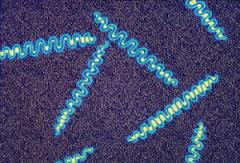Syphilis - transmitted infection that affects the skin, mucous membranes, internal organs, bone and nervous systems, and the causative agent of which is a bacterium - treponema pallidum (pale spirochete).
There are three theories of the origin of syphilis - American, European and African. So, according to the American «version»,the disease was brought to Europe by Columbus sailors. In South America, diseases caused by spirochetes are endemic. And the carriers of spirochetes are llamas. Some scientists have suggested that the pathogen transmission chain is as follows: llamas - natives - sailors. That is, the aborigines did not disdain bestiality, and this fact is confirmed by some historical chronicles of the Columbian time.
According to the second theory, there is no contribution of sailors to the spread of syphilis throughout Europe, since the disease has existed there for centuries. Even in Greek myths there is a story about how the Olympic gods punished the Athenians with genital diseases. Just the obstinate inhabitants of Athens did not show due respect to the phallus of Dionysus.
In China, syphilis was known as far back as 2000 BC, and were treated with mercury-containing agents. And in Transbaikalia they found ancient human remains, with syphilitic bone damage. In short, syphilis is the same ancient disease as medical science itself.
According to another theory, the cradle of syphilis is Central Africa. In addition to classical syphilis, a disease of pint was found there (the causative agent is treponema carriagea). From here comes the causative agent of non-venereal syphilis - frambesia. Pinta and frambesia are endemic treponematoses that have been found on the mainland from antediluvian times to today. From Africa, syphilis spread around the world with slaves and crusades.
Typical routes of infection with syphilis are sexual, hematogenous and intrauterine. The first symptom of the disease is the appearance of a solid chancre (ulcer) 14 to 28 days after infection. Chancres are mostly painless. Localization places - genitals, anal region, oral cavity. After about a month and a half, the ulcer seems to «hea». After the chancre «healed» the secondary period of the disease begins (if not treated).
Clinical signs of syphilis:
- pink rashes on the soles and palms;
- joint pain ;
- loss of appetite;
- weight loss;
- a sore throat.
These symptoms can persist up to six months, periodically disappearing and reappearing.
When all symptoms disappear, syphilis goes into a latent phase. The patient is no longer contagious, but treponema has already successfully invaded all tissues. Then the disease passes into its tertiary period, the heart, eyes, spinal cord and brain are seriously affected, paralysis, mental disorders and death are possible.
Diagnosis of syphilis
Syphilis is diagnosed by the results of blood tests. There are rapid tests for syphilis and more laborious methods for detecting the pathogen. The liquid taken from chancre is examined. As a rule, treponema is found in it.
Syphilis treatment
Syphilis is treated with penicillin antibiotics. Tertiary syphilis requires a fairly long course. But, usually, the treatment of the disease is successful. The patient's sexual partners should undergo preventive antibiotic therapy even with negative tests.

















